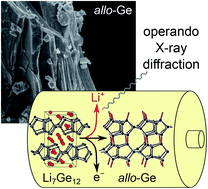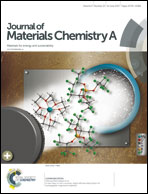Electrochemical synthesis of the allotrope allo-Ge and investigations on its use as an anode material†
Abstract
Due to the high lithium-ion mobility and high theoretical capacity, elemental germanium is an interesting candidate for anode materials. The layered Ge modification allo-Ge just recently obtained as a microcrystalline powder by topochemical oxidation of Li7Ge12 with ethanol has now for the first time been observed by electrochemical delithiation of Li7Ge12. The investigation of the Li-ion battery performance of allo-Ge is reported with operando PXRD phase monitoring compared to α-Ge. In addition, an alternative synthesis of Li7Ge12 by reaction of LiGe and α-Ge is presented. Cycling experiments of coin half-cells containing allo-Ge and α-Ge electrodes, respectively, show that the cycling stability of allo-Ge is inferior to common α-Ge. After an initial amorphization step, all Ge half-cells shuttle between the following phases: crystalline Li15Ge4 ↔ amorphous phase (most likely Li13Ge4) ↔ crystalline Li7Ge3 ↔ amorphous Ge. According to operando PXRD, allo-Ge capacity losses during cycling seem to be characterized by electronically disconnected Li7Ge3. The inferior cycling stability of allo-Ge, which consists of stacked Ge sheets, is therefore attributed to a morphological predisposition towards aging for consistency and contact loss in LIBs.



 Please wait while we load your content...
Please wait while we load your content...